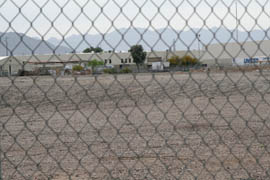Cronkite News has moved to a new home at cronkitenews.azpbs.org. Use this site to search archives from 2011 to May 2015. You can search the new site for current stories.
ADEQ celebrates completing cleanup of first state superfund site
PHOENIX – In 1999, the Arizona Department of Environmental Quality declared this 10-acre lot near downtown, formerly an automobile salvage yard, a state superfund site.
Today, after years spent removing soil contaminated by shredded metal, broken glass and torn hoses, the work is done, making this the first of 36 state superfund sites to be removed from the list.
Soon, a new company will occupy the former East Washington Fluff site.
Andre Chiaradia, manager of ADEQ’s Remedial Projects Unit, said completing the work represents a milestone for the agency.
“I’m a resident of Phoenix, so I want to see people employed and I want to see the growth of the city,” he said. “Not not seeing an empty lot in the future is something that would benefit me as a citizen as well as my position in the state agency.”
The original owners, National Metals Co., declared bankruptcy and abandoned the site in 1986, leaving behind thousands of tons of rubble that over time contaminated the soil.
The site, at East Buckeye Road and South Fifth Street, was added to the Water Quality Assurance Revolving Fund registry after ADEQ determined it was contaminated with levels of lead and other chemicals that exceeded the health standards of the state and the U.S. Environmental Protection Agency.
“The fluff sites are really a byproduct of our automobile age,” Chiaradia said. “In turning the automobiles back into something useful and removing the scrap metal, the process of breaking apart the cars generates this portion of waste that essentially has hazardous components in it.”
No groundwater contamination was found at the site, but over 6,000 tons of hazardous and solid waste material had to be removed from the ground in 2001, costing the agency about $3 million. A protective soil cap was added to prevent the contamination from spreading any further.
At a public auction in 2006, Jim Harrison bought the property, but a soil sampling two years later under a concrete slab he removed showed low levels of lead contamination. Harrison said he is relieved the cleanup efforts have finally paid off.
“Patience is a virtue, but this is one of the gems of Phoenix,” he said. “To have this big of a site right in the inner city and the opportunity to redevelop it is something you don’t get every day.”
After another 235 tons of soil was removed, recycled concrete was crushed and put in place as an additional layer over the original soil cap.
Now that the site is no longer a state superfund site, Harrison said the property’s size and location have already interested a prospective buyer. A confidentiality agreement prevented Harrison from giving the name, but he said it is a large company that already has operations in the area.
Chiaradia said the achievement is a victory for Phoenix as well.
“Where we have an opportunity to give the owner the mechanisms to turn the property over to be productive, it really fulfills all the goals that we have,” he said.
There are still 35 sites remaining on the state superfund list, but Tina LePage, manager of the Waste Programs Division’s Remedial Projects Section at ADEQ, said the East Washington Fluff site has provided a framework for completing work at other sites. A few other sites are nearing completion, she added.
“We understand that it’s a long process and that it took many years to get to the goal, but we did achieve the goal,” she said. “It’s a learning process, but it’s one that we’ll use now for the other sites and the new ones to come to finish this process faster.”








